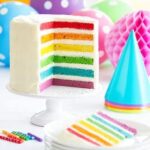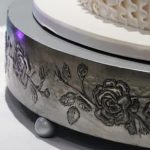Can I decorate a cake with buttercream and fondant? Buttercream and fondant are two widely popular methods for decorating cakes, each with its own unique characteristics. While buttercream is known for its creamy texture and rich taste, fondant offers a smooth and polished finish. In this article, we will explore the differences between these two techniques and discuss their pros and cons in cake decorating.
Buttercream is favored for its versatility, making it easy to work with for creating intricate designs or simple decorations. Its creamy texture allows for smooth piping, making it ideal for borders, flowers, and other details on cakes. On the other hand, fondant provides a clean canvas for design, allowing for precise shapes and intricate detailing that may be challenging to achieve with buttercream alone.
While both buttercream and fondant have their advantages, some decorators may wonder if they can combine these two methods to achieve the best of both worlds in cake decoration. In the following sections, we will delve into whether it’s possible to decorate a cake with buttercream and fondant together, along with tips on how to successfully marry these two techniques for stunning results.
Understanding the Differences Between Buttercream and Fondant in Terms of Taste and Texture
When it comes to cake decoration, understanding the differences between buttercream and fondant in terms of taste and texture is essential. Buttercream is a creamy, smooth mixture made with butter, powdered sugar, and flavorings like vanilla or chocolate. It has a rich and indulgent taste, making it a popular choice for those who enjoy a more traditional cake experience. In terms of texture, buttercream is soft and spreadable, making it ideal for creating smooth finishes on cakes.
On the other hand, fondant is a rolled icing made from sugar, water, and gelatin. It has a sweet taste similar to marshmallows and provides a smooth and polished look to cakes. Fondant can also be molded into intricate shapes and designs, offering a more versatile option for decorative elements on cakes. However, some people find fondant too sweet or chewy in texture compared to buttercream.
In terms of taste preference, some may prefer the buttercream for its rich flavor while others may enjoy the versatility of fondant for decorative purposes. When deciding which to use for cake decoration, consider both the taste preferences of your audience as well as the design needs of your cake. Experimenting with different combinations of buttercream and fondant can result in visually stunning cakes that cater to various tastes and preferences.
| Buttercream | Fondant |
|---|---|
| Rich and indulgent taste | Sweet taste similar to marshmallows |
| Soft and spreadable texture | Smooth and polished texture |
| Ideal for creating smooth finishes on cakes | Molded into intricate shapes and designs |
Pros and Cons of Using Buttercream for Cake Decoration
Buttercream is a classic choice for cake decoration due to its creamy texture and delicious flavor. One of the biggest advantages of using buttercream is its versatility – it can be easily colored, flavored, and piped into various designs. Buttercream also has a smooth and soft consistency that makes it ideal for creating intricate details on cakes. Additionally, buttercream is more forgiving than fondant when it comes to mistakes, as it can be easily adjusted or smoothed out.
However, there are some drawbacks to using buttercream for cake decoration. One of the main cons is that buttercream does not hold up as well in warmer temperatures compared to fondant.
This means that cakes decorated with buttercream may need to be refrigerated until serving to prevent melting or smudging. Another downside is that buttercream can be more challenging to work with when creating sharp edges or smooth finishes on cakes, requiring more skill and practice to achieve professional-looking results.
Despite the challenges, many bakers prefer the taste and texture of buttercream over fondant. Buttercream typically has a rich and luscious flavor that complements a variety of cake flavors.
It also provides a moist and decadent finish to cakes that can be hard to achieve with fondant alone. While each method has its own set of pros and cons, combining buttercream and fondant can i decorate a cake with buttercream and fondant together opens up endless possibilities for creative cake decorating techniques.
| Pros of Using Buttercream | Cons of Using Buttercream |
|---|---|
| Versatile in terms of color and flavor options | May not hold up well in warmer temperatures |
| Smooth and soft consistency for detailed designs | More challenging to create sharp edges |
| Skill required but forgiving for adjustments | Potential need for refrigeration before serving |
Pros and Cons of Using Fondant for Cake Decoration
Fondant has become a popular choice for cake decorators due to its versatility and smooth finish. One of the main advantages of using fondant is its ability to create intricate designs with sharp edges, making it perfect for cakes that require a clean and polished look. Fondant also provides a blank canvas for decorators to unleash their creativity, as it can be easily colored, shaped, and molded into various decorations such as flowers, figures, and textures.
However, one of the drawbacks of fondant is its taste. Some people find fondant too sweet or have a dislike for its chewy texture. While there are different types of fondant available on the market, some may still find it difficult to please everyone’s taste buds. Additionally, working with fondant requires some skill and practice to ensure a flawless finish on cakes. It can be challenging to cover larger cakes without getting wrinkles or air bubbles in the fondant.
Despite these drawbacks, many professional bakers and decorators swear by fondant for creating stunning showpiece cakes that are sure to impress at any event. With a little patience and practice, anyone can master the art of working with fondant and elevate their cake decorating skills to new heights. Just remember that while fondant may not be everyone’s favorite in terms of taste, its visual appeal cannot be denied when used correctly in combination with other decorating techniques like buttercream.
Can I Decorate a Cake With Buttercream and Fondant Together?
While both buttercream and fondant are popular choices for decorating cakes, some may wonder if it’s possible to combine the two techniques to create a truly stunning cake design. The answer is yes, you can decorate a cake with buttercream and fondant together. By using both buttercream and fondant in your cake decorating process, you can achieve a beautiful and professional-looking finish that combines the best of both worlds.
Benefits of Using Both Buttercream and Fondant
One of the main advantages of using both buttercream and fondant in cake decoration is the versatility it offers. Buttercream is great for creating smooth finishes, piped borders, and intricate designs, while fondant is perfect for covering larger cakes with a flawless, matte finish. By combining the two, you can achieve a range of textures and effects that would be difficult to create with just one method alone.
Another benefit of using both buttercream and fondant together is that it allows you to play with different flavors and textures. Buttercream adds a creamy richness to the cake, while fondant provides a sweet and slightly chewy element. By layering buttercream underneath a thin sheet of fondant or using them together in specific areas of your design, you can create a delicious combination that will impress your guests.
Tips for Successfully Combining Buttercream and Fondant
When working with both buttercream and fondant on a cake, it’s essential to ensure that the layers adhere well to each other. To do this, apply a thin layer of buttercream on the cake before adding the fondant on top.
This will help the fondant stick securely to the cake and prevent any air bubbles from forming. Additionally, make sure to work quickly when covering your cake with fondant after applying the initial layer of buttercream to prevent drying out or cracking issues.
Experimenting with different techniques such as marbling or creating textured effects by blending buttercream and fondant can also add depth and dimension to your cake design. Don’t be afraid to get creative and try out new ideas when combining these two popular cake decorating methods – the possibilities are endless.
Tips and Tricks on How to Successfully Combine Buttercream and Fondant for Cake Decoration
Buttercream and fondant are two popular options for decorating cakes, each offering unique advantages and disadvantages. While buttercream is known for its creamy texture and rich flavor, fondant provides a smooth and flawless finish that can be easily molded into intricate designs. However, many bakers often wonder if they can combine both buttercream and fondant to achieve the best of both worlds in cake decoration.
Here are some tips and tricks on how you can successfully combine buttercream and fondant for cake decoration:
- Start with a crumb coat: Before applying fondant to your cake, it’s essential to first cover it with a thin layer of buttercream. This initial coat, known as a crumb coat, helps smooth out the surface of the cake and prevent any crumbs from showing through the fondant.
- Chill your cake: After applying the crumb coat, chill your cake in the refrigerator for at least 30 minutes. This will firm up the buttercream, making it easier to work with when adding the fondant.
- Roll out the fondant: Once the buttercream has chilled, roll out your fondant to the desired thickness using a rolling pin dusted with powdered sugar or cornstarch to prevent sticking.
Combining buttercream and fondant allows you to create stunning designs that are not only visually appealing but also delicious. By following these tips and tricks, you can elevate your cake decorating skills and impress your friends and family with beautifully decorated treats that seamlessly blend the best of both worlds – buttercream’s richness and flavor with fondant’s smooth finish. So go ahead, experiment with different techniques and unleash your creativity in decorating cakes with buttercream and fondant.
Step-by-Step Guide on How to Decorate a Cake With Buttercream and Fondant
Decorating a cake with a combination of buttercream and fondant opens up endless possibilities for creative and beautiful designs. By utilizing the unique qualities of each decorating method, you can achieve a truly stunning result that will impress your friends and family. Here is a step-by-step guide to help you successfully decorate a cake with buttercream and fondant:
- Start by baking your desired cake base and allowing it to cool completely.
- Prepare a batch of smooth buttercream frosting in your chosen flavor and color. This will serve as the “glue” to adhere the fondant decorations to the cake.
- Cover the entire cake with a thin layer of buttercream frosting, also known as a crumb coat, to seal in any loose crumbs. Chill the cake in the refrigerator for about 15-20 minutes to set the frosting.
- Roll out your fondant on a clean surface dusted with powdered sugar or cornstarch to prevent sticking. Carefully lift the rolled fondant using a rolling pin and drape it over the chilled cake.
Combining both buttercream and fondant allows you to create intricate details, textures, and designs on your cake that would be difficult to achieve with just one decorating method alone. From elegant florals to fun character themes, there are endless possibilities when it comes to decorating cakes with this versatile duo.
Whether you are a beginner or experienced baker, experimenting with buttercream and fondant decorations can elevate your cakes to new heights. With practice, patience, and creativity, you can create show-stopping cakes that are not only visually stunning but also delicious to eat. So go ahead, unleash your inner pastry artist, and have fun decorating cakes with buttercream and fondant.
Inspiration and Ideas for Creating Stunning Designs Using Both Buttercream and Fondant on Cakes
Buttercream and fondant are two popular cake decorating methods that offer endless possibilities for creating stunning designs. While each has its own unique qualities, they can also be used together to achieve a beautiful and professional-looking finish on cakes.
Combining buttercream and fondant allows decorators to take advantage of the best of both worlds. Buttercream is known for its rich and creamy taste, while fondant provides a smooth and polished finish. By using both techniques in tandem, decorators can create intricate designs that are not only visually appealing but also delicious to eat.
One of the most common ways to combine buttercream and fondant is to use buttercream as the base layer for the cake and then add fondant accents on top. This technique allows decorators to achieve a clean and smooth canvas for their fondant decorations, ensuring that every detail stands out beautifully. Additionally, the versatility of buttercream means that it can be easily flavored or colored to complement the overall design of the cake.
When combining buttercream and fondant on a cake, it’s important to consider factors such as temperature and consistency. Buttercream should be chilled before applying fondant accents to prevent it from melting or becoming too soft. Additionally, using a thin layer of buttercream as a crumb coat can help ensure that the fondant adheres smoothly to the cake surface. With careful planning and execution, decorators
Conclusion
In conclusion, the art of cake decorating with buttercream and fondant offers a wide array of possibilities for creating stunning and unique designs. Both buttercream and fondant have their distinct advantages and disadvantages, allowing decorators to experiment with different techniques and textures to achieve their desired results. While buttercream provides a deliciously creamy taste and smooth finish, fondant offers a more polished look with its ability to create intricate details.
Combining buttercream and fondant on a cake opens up endless creative possibilities, allowing decorators to play with different textures, colors, and designs. By layering buttercream as the base and adding fondant accents or decorations on top, decorators can achieve a beautifully balanced look that is both visually appealing and tasty. The versatility of these two mediums allows for endless customization, making it possible to create cakes for any occasion or theme.
remember that with some practice and creativity, the answer is undoubtedly yes. Let your imagination run wild as you explore the world of cake decorating with buttercream and fondant.
Frequently Asked Questions
Can You Use Buttercream and Fondant on the Same Cake?
Yes, you can use both buttercream and fondant on the same cake. Buttercream can be used as a base layer to provide a smooth surface for the fondant to adhere to. The buttercream adds flavor while the fondant gives a clean, polished look.
Does Buttercream Go Under Fondant?
Buttercream is often used under fondant to create a smooth surface for the fondant to stick to. The layer of buttercream helps provide stability and acts as an adhesive for the fondant. This combination is commonly used in cake decorating.
Can You Attach Fondant to Buttercream?
Fondant can be easily attached to buttercream as long as it is done correctly. It’s essential to ensure that the buttercream layer is not too thick or too thin, as this can affect how well the fondant adheres to it. Properly preparing and smoothing out the buttercream will help the fondant stick securely without any issues.

Welcome to my blog about home and family. This blog is a place where I will share my thoughts, ideas, and experiences related to these important topics. I am a stay-at-home mom with two young children. I hope you enjoy reading it! and may find some helpful tips and ideas that will make your home and family life even better!





